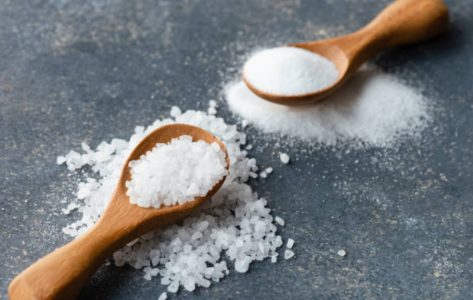Desserts secretly increase heart attack risk as hidden ingredient triggers danger
By
Gian T
- Replies 0
If you’re like most Aussies, you probably enjoy a sweet treat now and then—maybe a chewy caramel slice, a buttery biscuit, or a soft pretzel at the markets.
But did you know that a surprising ingredient hiding in many of our favourite desserts could be quietly raising your risk of a heart attack?
We’re not talking about sugar this time. The real issue lies with those large, crunchy crystals often sprinkled on sweet or savoury treats.
Many people believe that sea salt is a healthier alternative to regular table salt. But here’s the kicker: both contain roughly the same amount of sodium—about 40 per cent.
The difference is in the texture. Coarse salt’s larger crystals can trick your taste buds, making each bite feel less salty.
As a result, you might end up using more than you would with acceptable salt, unknowingly increasing your sodium intake.
And it’s not just the desserts you need to watch out for. Salt is everywhere in the Western diet—hidden in pieces of bread, canned soups, frozen meals, cheeses, sauces, and marinades.
Even foods that don’t taste particularly salty can be loaded with sodium.
The body only needs a small amount of sodium to function properly.
It’s essential for maintaining fluid balance, supporting nerve function, and enabling muscle contractions.
But most Australians (and Americans, for that matter) are getting far more than they need.
The recommended daily limit is 2,300mg, but the average intake is closer to 3,300mg—a whopping 40 per cent over the limit!
According to health experts, approximately 89 per cent of adults and 94 per cent of children consume too much sodium.
The World Health Organization estimates that 1.9 million deaths globally each year can be attributed to excessive salt intake.
When you eat too much salt, your body retains extra fluid to dilute the sodium in your bloodstream.
This increases the volume of blood, putting more pressure on your artery walls.
Over time, this can lead to high blood pressure—a major risk factor for heart disease, stroke, and kidney problems.
Dr Brent Egan, a leading cardiovascular health expert, says that even a modest reduction in sodium—about 1,000mg a day—could lead to significant drops in blood pressure, heart attacks, and strokes.
For those with high blood pressure or heart disease, aiming for 1,500mg per day is even better.
But the effects of excess salt don’t stop at your heart. Too much sodium can also cause bloating, swelling in your hands and feet, increased thirst, and even restless sleep.
High-salt diets may disrupt your body’s stress hormones, making it harder to get a good night’s rest.
Absolutely! A recent study from Vanderbilt University found that reducing daily salt intake by just one teaspoon (about 2,300mg) was as effective at lowering blood pressure as some common medications.
Participants who cut out just one can of salty soup a day saw their blood pressure drop by 6 per cent in a week.
We all deserve to enjoy a treat now and then, but it pays to be aware of what’s really in our food—especially as we get older and our risk for heart disease increases.
Next time you’re tempted by a salted caramel slice or a pretzel, remember: a little salt goes a long way.
 Have you noticed more salty desserts popping up at your local bakery or supermarket? Do you check the sodium content on food labels, or have you found clever ways to cut back on salt in your diet? Share your tips and experiences in the comments below.
Have you noticed more salty desserts popping up at your local bakery or supermarket? Do you check the sodium content on food labels, or have you found clever ways to cut back on salt in your diet? Share your tips and experiences in the comments below.
Read more: How Cutting Just a Pinch of Salt from Your Diet Could Add Years to Your Life, According to Latest Australian Research!
But did you know that a surprising ingredient hiding in many of our favourite desserts could be quietly raising your risk of a heart attack?
We’re not talking about sugar this time. The real issue lies with those large, crunchy crystals often sprinkled on sweet or savoury treats.
Many people believe that sea salt is a healthier alternative to regular table salt. But here’s the kicker: both contain roughly the same amount of sodium—about 40 per cent.
The difference is in the texture. Coarse salt’s larger crystals can trick your taste buds, making each bite feel less salty.
As a result, you might end up using more than you would with acceptable salt, unknowingly increasing your sodium intake.
And it’s not just the desserts you need to watch out for. Salt is everywhere in the Western diet—hidden in pieces of bread, canned soups, frozen meals, cheeses, sauces, and marinades.
Even foods that don’t taste particularly salty can be loaded with sodium.
The body only needs a small amount of sodium to function properly.
It’s essential for maintaining fluid balance, supporting nerve function, and enabling muscle contractions.
But most Australians (and Americans, for that matter) are getting far more than they need.
The recommended daily limit is 2,300mg, but the average intake is closer to 3,300mg—a whopping 40 per cent over the limit!
According to health experts, approximately 89 per cent of adults and 94 per cent of children consume too much sodium.
The World Health Organization estimates that 1.9 million deaths globally each year can be attributed to excessive salt intake.
When you eat too much salt, your body retains extra fluid to dilute the sodium in your bloodstream.
Over time, this can lead to high blood pressure—a major risk factor for heart disease, stroke, and kidney problems.
Dr Brent Egan, a leading cardiovascular health expert, says that even a modest reduction in sodium—about 1,000mg a day—could lead to significant drops in blood pressure, heart attacks, and strokes.
For those with high blood pressure or heart disease, aiming for 1,500mg per day is even better.
But the effects of excess salt don’t stop at your heart. Too much sodium can also cause bloating, swelling in your hands and feet, increased thirst, and even restless sleep.
High-salt diets may disrupt your body’s stress hormones, making it harder to get a good night’s rest.
Participants who cut out just one can of salty soup a day saw their blood pressure drop by 6 per cent in a week.
We all deserve to enjoy a treat now and then, but it pays to be aware of what’s really in our food—especially as we get older and our risk for heart disease increases.
Next time you’re tempted by a salted caramel slice or a pretzel, remember: a little salt goes a long way.
Key Takeaways
- Cardiologists are warning that coarse sea salt, often sprinkled on desserts and baked goods, contains just as much sodium as regular table salt and can contribute to high blood pressure and heart disease if overused.
- Many people mistakenly believe coarse sea salt is healthier, but both it and fine salt contain about 40 per cent sodium and should be used sparingly to avoid exceeding the recommended daily limit.
- Excessive salt intake is widespread, with nearly 90 per cent of adults and 94 per cent of children consuming too much sodium, which increases the risks of heart attack, stroke, and kidney disease and even disrupts sleep.
- Cutting back daily salt intake by just one teaspoon can lower blood pressure significantly—on par with some medications—highlighting the importance of checking for hidden salt in foods and being mindful of salt used in cooking and garnishes.
Read more: How Cutting Just a Pinch of Salt from Your Diet Could Add Years to Your Life, According to Latest Australian Research!








